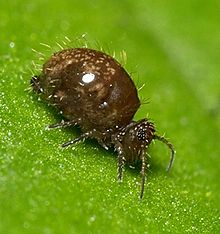Allacma fusca is a species of springtail. This species is endemic to western areas of Continental Europe and the British Isles,[1][2] where it lives in the surface layers of the soil in moist habitats such as among leaf litter.
| Allacma fusca | |
|---|---|

| |
| Allacma fusca on rotting wood | |
| Scientific classification | |
| Domain: | Eukaryota |
| Kingdom: | Animalia |
| Phylum: | Arthropoda |
| Subclass: | Collembola |
| Order: | Symphypleona |
| Family: | Sminthuridae |
| Genus: | Allacma |
| Species: | A. fusca
|
| Binomial name | |
| Allacma fusca | |
Description
editAllacma fusca is a large species of springtail with a dark brown globular abdomen; adults reach a length of around 3.5 mm (0.14 in).[3] There is often a "snowflake"-like marking on the abdomen, which is most noticeable in paler coloured individuals.[4] The mouthparts are internal, and the head bears a pair of antennae, two groups of eyespots known as "composed eyes" and a pair of small post-antennal organs. The setae (bristles) on the third antennal segment are unequal in length, some being much longer than others, and the fourth antennal segment is divided into sixteen sub-segments. There are three thoracial segments, each bearing a leg, and five abdominal segments. The fourth abdominal segment bears an organ known as a "dens", and at the tip of this is a structure known as a "mucro". This species has mucros with smooth outer edges and saw-edged inner edges. In females, the appendage on the fifth abdominal segment is unforked.[3][5]
Distribution and habitat
editThis springtail is native to Western Europe. It is common in the British Isles and inhabits moist terrestrial environments such as plant litter.[3]
Ecology
editInvertebrates living among the soil particles in underground habitats often experience raised levels of carbon dioxide, which tends to increase with depth. Researchers have found that the surface-dwelling Allacma fusca can tolerate a 10% level of carbon dioxide for a few hours while in contrast, the springtail Folsomia candida, which lives deeper in the soil, can survive under the same conditions for more than six weeks.[6]
References
edit- ^ "Distribution of Allacma fusca". Fauna Europaea. Archived from the original on 22 June 2011. Retrieved 25 March 2010.
- ^ Hopkin, Steve (9 May 2006). "Allacma fusca in UK and Ireland". University of Reading. Archived from the original on 22 July 2011. Retrieved 6 March 2010.
- ^ a b c "(409 ALfus) Allacma fusca (Linnaeus, 1758)". Colembola. University of Roehampton. Retrieved 26 November 2018.
- ^ "Allacma fusca". BugGuide. Retrieved 1 November 2018.
- ^ Bellinger, P.F.; Christiansen, K.A.; Janssens, F. (1996–2018). "Colembola". Checklist of the Collembola of the World. Retrieved 26 November 2018.
- ^ Zinkler, D.; Platthaus, J. (1996). "Tolerance of soil-dwelling Collembola to high carbon dioxide concentrations" (PDF). European Journal of Entomology. 93: 443–450. ISSN 1210-5759.